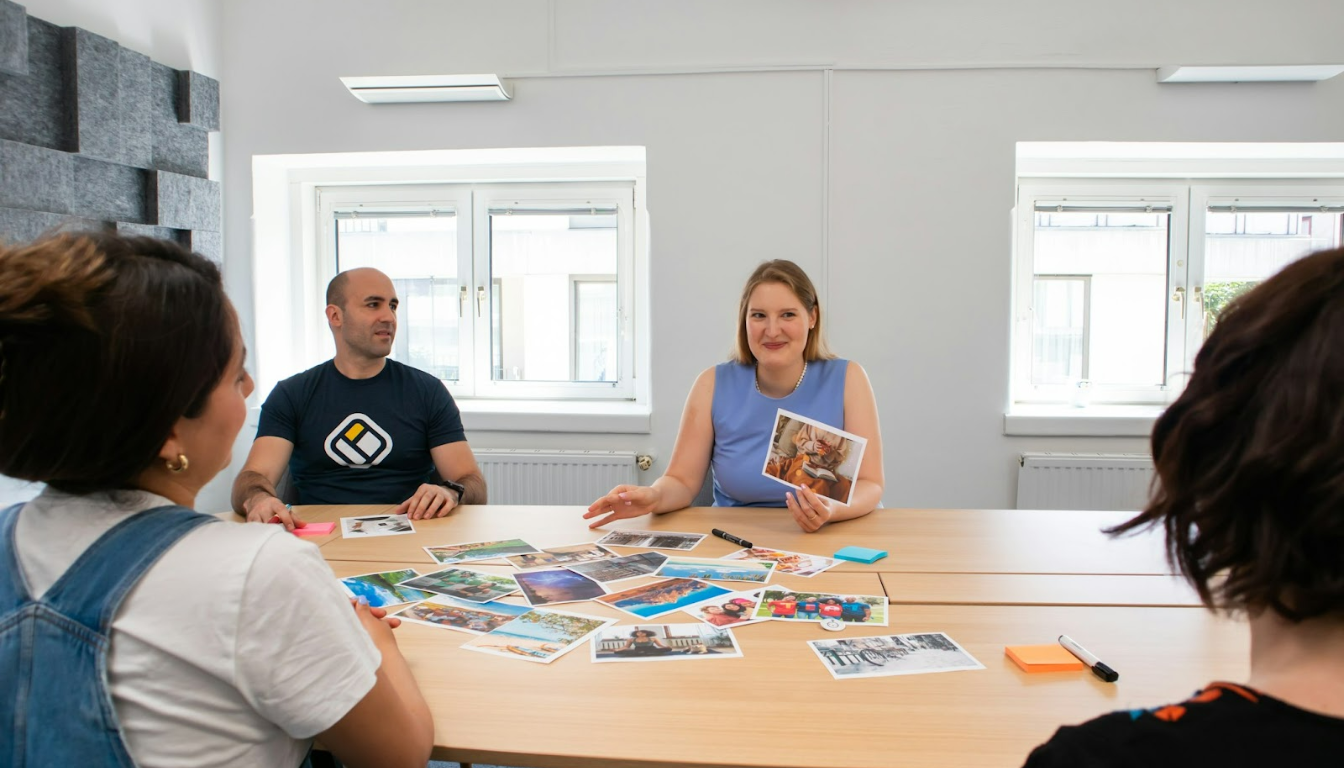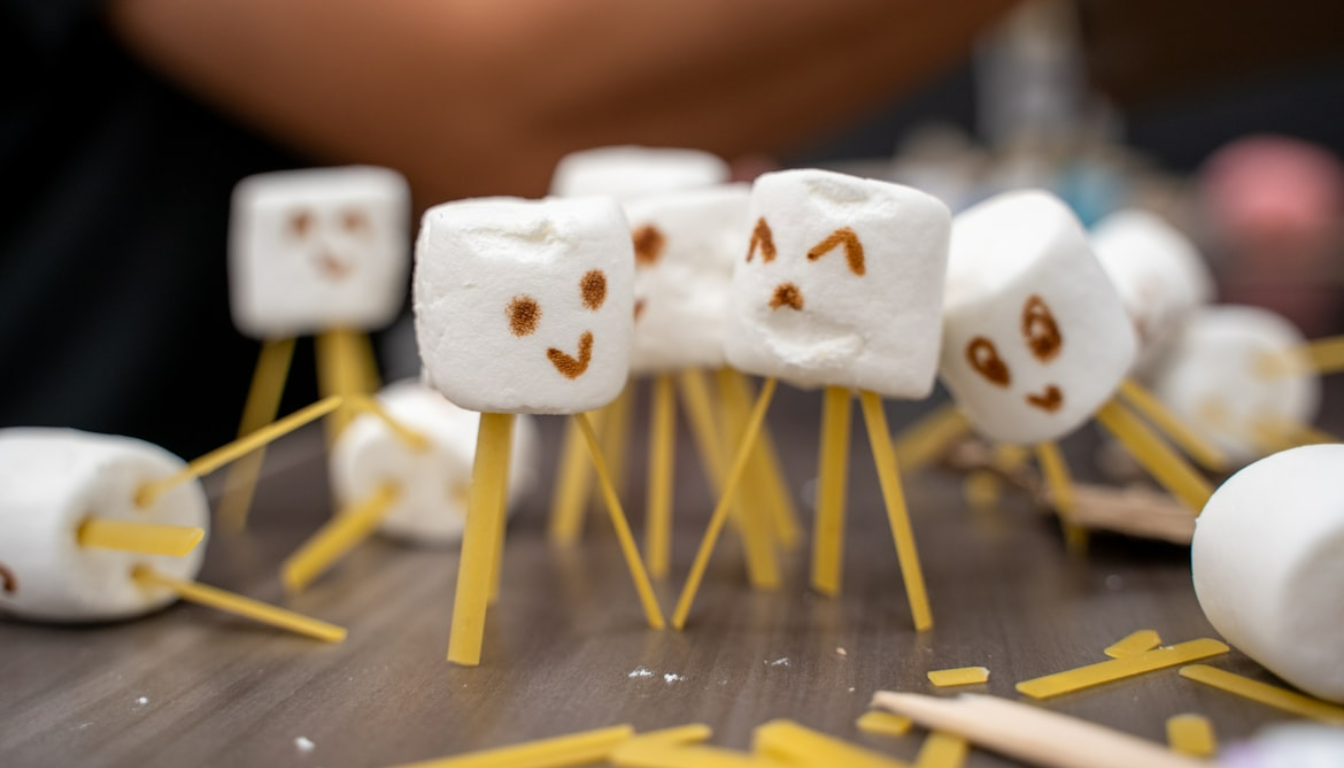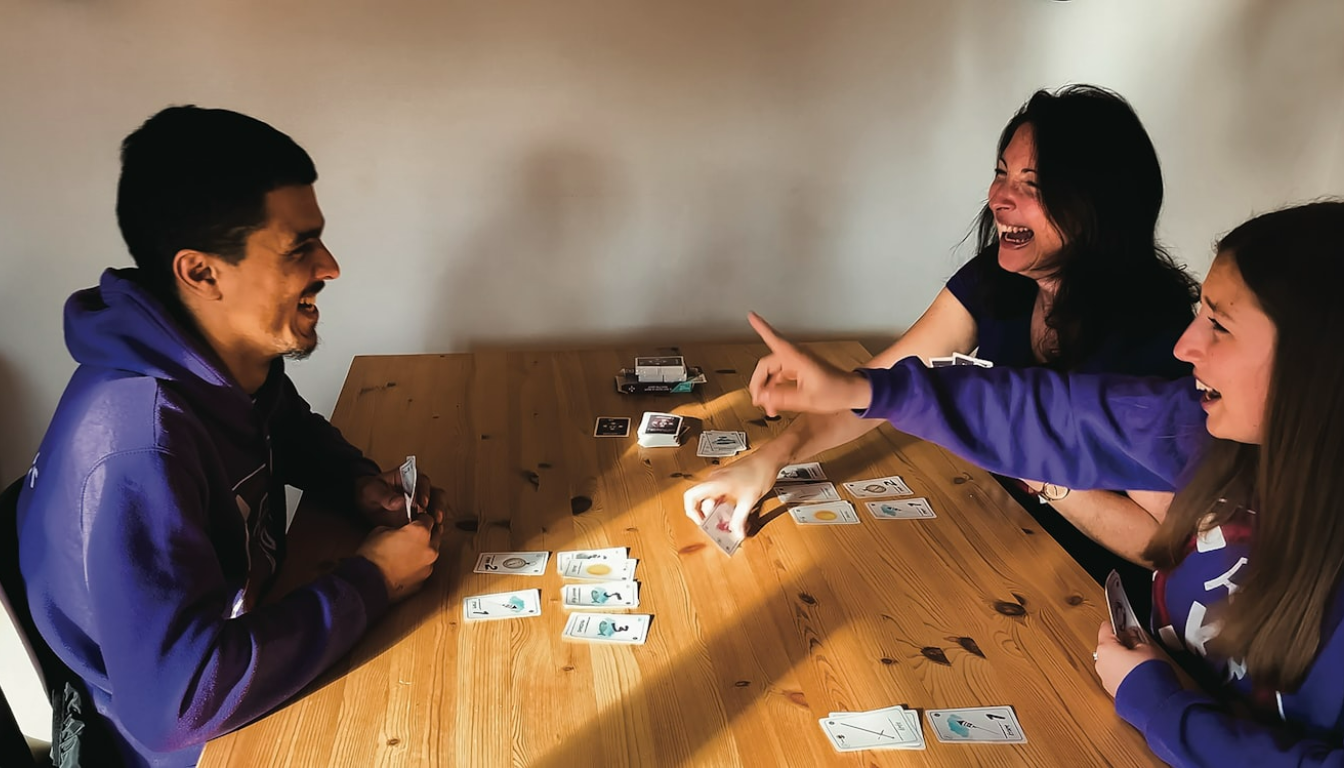30 Best Games for Adults Team Building Activities to Boost Camaraderie

Searching for ways to boost team cohesion and collaboration with fun, engaging activities? This guide to games for adults team building has you covered. Discover a variety of games designed to enhance communication, trust, and overall team dynamics. From icebreakers to problem-solving challenges, find the perfect activities to elevate your team’s performance.
Key Takeaways
- Team-building games significantly enhance collaboration, communication, and trust among team members, fostering a positive work environment.
- A diverse range of games, including icebreakers, problem-solving activities, and trust-building exercises, can deepen connections and improve team dynamics.
- Quick and engaging activities, both in-person and virtual, can effectively strengthen team cohesion, even in busy schedules.
Why Team Building Games for Adults Matter

Team-building games are crucial for transforming a regular team into a cohesive unit, enhancing overall team dynamics and interactions. These team games promote collaboration, strengthen bonds, and enhance understanding among adult team members. These activities help team members build trust, enhance communication, and collaborate towards common goals.
The right team building game improves team cohesion, group happiness, and employee engagement, which in turn boosts company culture. Effective team-building activities have a direct impact on enhancing morale and workplace satisfaction, leading to a thriving work environment. Trust is vital for teamwork and enhances overall connection and company culture, making it a key focus of team-building games.
Activities focused on improving team cohesion enhance:
- Employee happiness and productivity, fostering a more collaborative atmosphere.
- Empathy and communication skills, which are essential for effective team interactions.
- The integration of new recruits and foster deeper team connections through well-structured team-building activities.
Icebreaker Games to Kickstart Team Bonding

Icebreaker games are short activities aimed at engaging a group at the beginning of meetings or workshops, setting the stage for effective team bonding. These activities are designed to be fun and engaging, making them ideal for breaking down barriers and encouraging team members to get to know each other better. Whether you’re welcoming new team members or looking to energize your group, icebreakers are the perfect way to kickstart team bonding.
Three popular icebreaker games include Two Truths and a Lie, The One-Word Icebreaker Game, and Office Trivia. These are easy to set up and perfect for any team-building event.
Two Truths and a Lie
Two Truths and a Lie is a classic icebreaker game that helps participants share personal information in a fun way, facilitating acquaintance. The purpose of this game is to build familiarity between colleagues, making it easier for them to connect on a personal level. In this game, each participant shares two truths and one lie about themselves, and the group has to guess which statement is the lie.
The recommended group size for Two Truths and a Lie is 5-8 people, making it perfect for a small group of smaller teams. Participants need to create two facts and one lie, taking approximately 2-3 minutes each to share their statements.
The entire game typically takes about 30 minutes to complete, making it a quick and effective way to break the ice and get to know each other better in a few minutes.
The One-Word Icebreaker Game
The One-Word Icebreaker Game encourages team members to express their feelings or thoughts about a topic using just a single word. This game is a great way to quickly gauge the mood of the group and get everyone thinking creatively.
It’s a simple yet effective way to start a team meeting or workshop, setting the tone for open communication and collaboration.
Office Trivia
Office Trivia is a fun and engaging way to encourage collaboration and friendly competition among team members. This game promotes familiarity among new team members by encouraging them to engage with colleagues through shared company facts. Trivia games and office games offer bonding experiences, competitive fun, education, and entertainment, making them a great addition to any team-building event.
The recommended team size for Office Trivia is between 6 to 20 people, ensuring engagement and interaction among participants. The game typically lasts 30 to 45 minutes, making it a manageable activity for teams. Questions can cover themes like:
- Office facts
- TV shows
- Music
- And more to enhance engagement This activity helps break the ice and fosters a sense of camaraderie among team members.
Problem-Solving Games to Enhance Collaboration

Problem-solving games are designed to enhance teamwork, issue resolution, goal achievement, and overall performance. These activities require team members to work together to solve challenges, fostering a sense of collaboration and unity. Problem-solving games help teams develop critical thinking skills and improve their collaboration.
Three popular problem-solving games include The Marshmallow Challenge, Escape Room Challenge, and Code Break. These activities are fun, engaging, and enhance problem-solving skills and teamwork.
Let’s dive into these exciting activities.
The Marshmallow Challenge
The Marshmallow Challenge requires teams to build a tower that supports a marshmallow using limited materials. This activity involves:
- 20 sticks of uncooked spaghetti
- One yard of tape
- One yard of string
- One marshmallow
The goal is to construct the tallest freestanding structure possible within the given constraints. The challenge encourages participants to think creatively and collaboratively, improving their problem-solving and communication skills.
The recommended group size for the Marshmallow Challenge is 4 members, making it ideal for small teams. Key aspects of the activity include:
- Duration: Typically takes 20-30 minutes to complete, providing a quick yet impactful team-building experience.
- Engagement: A great way to engage team members in a fun and competitive environment.
- Benefits: Fosters innovation and teamwork.
Escape Room Challenge
Escape Room Challenges are designed to improve teamwork and problem-solving skills under pressure. In this activity, teams are locked in a room and must solve a series of puzzles and clues to escape within a set time limit. The ideal team size for an Escape Room Challenge is 6-12 people, ensuring that everyone can participate and contribute to the solution.
The time commitment for an Escape Room Challenge is typically 60-90 minutes, making it a substantial but highly rewarding team-building activity. Participating in an escape room challenge reveals team strengths and weaknesses, fosters communication, builds trust, and creates shared memories.
This team building exercise works perfectly for teams looking to enhance their problem-solving abilities and strengthen their bonds through team building exercises.
Code Break
Code Break is a problem-solving game that accommodates teams of 8 to 24 people and typically lasts between 1 to 3 hours. In this game, teams work together to crack codes, requiring effective communication and strategic thinking. The activity involves solving a series of puzzles that challenge participants to think creatively and collaboratively.
By collaborating in large groups to solve puzzles, participants enhance their creativity and problem-solving skills. Overall, the Code Break game significantly boosts teamwork by encouraging participants to think creatively and work together towards a common goal.
This activity is perfect for teams looking to enhance their strategic thinking and collaboration skills.
Creative Thinking Games for Innovative Solutions

Creative thinking games are essential for fostering innovation and teamwork. These activities challenge participants to think outside the box and come up with innovative solutions to problems. Creative thinking games help teams generate new ideas and approach challenges from different perspectives.
Three popular creative thinking games include Paper Tower Challenge, Sales Pitch, and Innovators’ Auction. These activities promote teamwork, creativity, and strategic thinking.
Let’s dive into these exciting activities and discover how they can inspire innovative solutions within your team.
Paper Tower Challenge
The Paper Tower Challenge involves teams using limited materials to construct the tallest tower possible. Participants use basic materials like paper and tape to build their structures, fostering innovation and strategic thinking. The purpose of the Paper Tower Challenge is to encourage team members to come up with innovative designs and work together to achieve a common goal.
Each team typically consists of 4-8 members, and the challenge lasts 20-30 minutes, making it a quick and effective team-building activity. This fun and engaging game helps teams develop their creative thinking and problem-solving skills, making it an excellent addition to any team-building event.
Sales Pitch
The Sales Pitch activity requires approximately 45 minutes and focuses on presenting a fictional product. In this game, participants create a logo, slogan, and marketing plan for a fictional product, developing creativity, teamwork, and public speaking skills. The activity known as ‘Sell It’ involves teams working together to brainstorm and present their ideas, fostering collaboration and innovation.
The recommended group size for the Sales Pitch is around 8 participants, ensuring effective collaboration and engagement. This activity is perfect for team meetings and workshops, providing a fun and engaging way for team members to practice their presentation skills and think creatively.
Innovators' Auction
In the Innovators’ Auction, teams must strategically bid on materials, fostering both negotiation skills and creative problem-solving. The bidding process involves teams using tokens to acquire materials that will aid them in creating their inventions. This game emphasizes the importance of negotiation and resource management, essential skills in both the game and real-world scenarios.
The Innovators’ Auction not only enhances creativity but also strengthens team dynamics through collaboration and strategic thinking. This activity is perfect for teams looking to develop their negotiation and problem-solving skills in a fun and competitive environment.
Communication Games for Better Understanding

Communication games are designed to help employees improve their communication skills, problem-solving abilities, and camaraderie. Effective communication is essential for collaboration among colleagues, enhancing team dynamics and productivity. Communication games help team members listen actively, articulate their thoughts clearly, and build stronger connections.
Three popular communication games include Back-to-Back Drawing, Blind Drawing, and Active Listening. These activities improve communication skills, foster understanding, and enhance team dynamics.
Back-to-Back Drawing
Back-to-Back Drawing enhances communication and listening skills among participants. In this activity, team members sit back-to-back, with one person describing a drawing while the other tries to replicate it based on the description. This exercise highlights the importance of clear communication and active listening, as participants must convey and interpret instructions accurately to ensure they are on the same page.
The activity requires a group of four or more people to effectively participate, making it suitable for small to medium-sized teams. The time requirement for Back-to-Back Drawing is between 5 to 10 minutes, making it a quick and effective way to improve communication skills within a team.
Blind Drawing
Blind Drawing can accommodate 4-30 people and typically lasts around 25 minutes. In this game, two participants sit back-to-back; one describes an image while the other draws it based on the description. This activity highlights the difficulty in giving clear instructions and emphasizes the importance of effective communication.
Materials needed for Blind Drawing include paper, writing utensils, and a selection of items or pictures to describe. This game helps team members improve their communication skills, fostering better understanding and collaboration within the team.
Active Listening
Active Listening exercises focus on improving listening and descriptive skills, essential for clear communication in teams. By engaging in activities like Back-to-Back Drawing and Blind Drawing, team members learn to pay attention to detail and articulate their thoughts more effectively. These exercises reveal differences in understanding, which is crucial for team dynamics.
Effective communication reduces misunderstandings and helps resolve conflicts. Practicing active listening builds stronger connections and promotes a collaborative environment.
Trust-Building Games for Stronger Teams
Trust-building games are essential for enhancing team cohesion and creating a positive workplace atmosphere. Effective team-building activities aim to create lasting bonds among team members, leading to improved connections and a stronger company culture. Trust-building exercises improve communication, trust, collaboration, and problem-solving skills.
In this section, we’ll explore three popular trust-building games: Human Knot, Minefield, and Birthday Lineup. These activities are designed to build trust, foster collaboration, and strengthen team dynamics.
Let’s dive into these games and discover how they can help your team become more cohesive and connected.
Human Knot
The purpose of the Human Knot game is to build collaboration among team members. In this activity, participants stand in a circle, reach across to hold hands with two different people, and then work together to untangle the human knot without letting go of each other’s hands. This game requires effective communication, trust, and teamwork to succeed.
The ideal group size for the Human Knot game is 8-16 people, making it suitable for small to medium-sized teams. The time commitment required for the game is 20-30 minutes, providing a quick yet impactful team-building experience.
Minefield
The Minefield game involves a team member navigating a minefield blindfolded while being guided by teammates through verbal instructions. The purpose of this activity is to improve trust and partnership among team members, as they must rely on each other to successfully navigate the minefield.
For the Minefield game:
- You need around 20 small objects.
- The activity typically takes about 15–30 minutes.
- If the blindfolded player hits an object within the minefield, they must start over.
This adds an element of challenge and requires clear communication and trust.
Birthday Lineup
The purpose of the Birthday Lineup game is to showcase cooperation and coordination skills among team members. In this activity, participants must line up in order of their birthdays without speaking to each other. This game encourages non-verbal communication and teamwork.
The group size requirement for the Birthday Lineup game is 8-15 people, making it suitable for small to medium-sized teams. The activity typically takes 20-30 minutes to complete, providing a quick and engaging way to build trust and cooperation within the team.
Fun Games to Boost Morale and Engagement
Fun games play a vital role in boosting team morale and engagement. These activities create a positive and energetic atmosphere, helping team members bond and enjoy their time together. Fun team-building games enhance team cohesion, creativity, and overall performance.
In this section, we’ll explore three popular fun games: Scavenger Hunt, Charades, and Board Games and Puzzles. These activities are designed to be entertaining and engaging, providing valuable opportunities for team bonding and collaboration.
Let’s dive into these games and discover how they can boost your team’s morale and engagement.
Scavenger Hunt
A scavenger hunt is an exciting and interactive team-building activity where:
- Teams work together to find hidden objects or complete tasks.
- It encourages bonding among team members who may not know each other well, fostering stronger connections and teamwork.
- The main objective is for teams to search for items and return first with the most, promoting friendly competition and collaboration.
A scavenger hunt typically involves:
- Duration: between 45-90 minutes, making it a substantial yet manageable activity for team-building events.
- Number of participants: ranges from 6 to 50 people.
- Suitable group size: usually between 8 to 16 people.
Items needed for a scavenger hunt include a scavenger hunt list and optionally smartphones. When well executed, scavenger hunts help participants understand both the physical and factual parts of the office.
Charades
Charades is a classic and fun game that involves acting out words or phrases for teammates to guess. This game is best played with teams of 8-10 people and typically lasts 10-25 minutes, serving as a fun mental break during stressful days. Charades encourages quick thinking, creativity, and teamwork, making it a great addition to any team-building event.
Reverse Charades is a variation where one person guesses while the rest of the team acts out the words, allowing for broader participation and engaging shyer individuals. This game promotes team bonding and provides a fun and engaging way to improve communication and collaboration within the team.
Board Games and Puzzles
Playing board games or puzzles promotes collaboration among team members. Examples of games that can be played include work puzzles, strategy games, and icebreaker games. These activities encourage strategic thinking, problem-solving, and teamwork, making them ideal for team-building events.
Board games can accommodate larger small groups by splitting into smaller teams for play. Typically, board games or puzzles require around 20-30 minutes to complete, making them a quick and effective way to engage team members.
Games like Carcassonne can be played by 2-6 players and involve scoring the highest points by laying tiles, providing a fun and competitive environment for team bonding.
Virtual Team Building Games for Remote Teams
Virtual team-building games are essential for engaging remote teams and maintaining team cohesion. Many team-building games can be adapted for virtual environments, ensuring inclusivity and participation from all team members regardless of their location. Scheduling activities during work hours and ensuring they suit all time zones helps remote teams stay connected and engaged.
In this section, we’ll explore three popular virtual team-building games: Online Group Games, Photo Caption Contest, and Show and Tell. These activities are designed to be fun and engaging, providing valuable opportunities for remote teams to bond and collaborate.
Let’s dive into these virtual games and discover how they can enhance your remote team dynamics.
Online Group Games
Online group games are a great way to engage remote teams and create a casual environment for team bonding. These games typically require 3 or more people and take about 30 to 60 minutes to play, making them suitable for virtual team-building sessions. One popular game is Drawful, where 3 to 8 players draw prompts and guess titles based on the drawings, providing entertainment and strengthening team connections.
Playing online group games over video calling software not only entertains but also helps build stronger relationships among team members. These games provide a fun and engaging way for remote teams to bond and collaborate, fostering a sense of unity and camaraderie, even when not meeting in person.
Photo Caption Contest
The photo caption contest is a fun activity that encourages creativity and laughter among team members. Key details include:
- Participants are given a selection of photos.
- They must come up with the most amusing or fitting captions within a set time frame.
- The activity requires a team size of 5 or more people.
- It typically lasts 10 to 15 minutes.
This makes it a quick and engaging way to boost team morale.
The photo caption contest fosters friendly competition and provides an opportunity for team members to showcase their creativity. By sharing and voting on captions, participants can bond over shared humor and build stronger connections within the team.
Show and Tell
Show and Tell is a virtual game that helps connect team members by allowing them to share personal items or stories. Key aspects of the game include:
- Each participant is allocated 2–3 minutes to present their item or story.
- The presentations provide valuable conversation starters and insights into participants’ lives.
- A minimum of 3 participants is required for effective engagement.
- The game is suitable for small to medium-sized remote teams.
Participants can show a wide range of items, including:
- pets
- plants
- paintings
- certificates
This fosters a sense of connection and camaraderie. Show and Tell is a fun and engaging way to build stronger relationships within remote teams, helping team members feel more connected and valued.
Strategic Thinking Games for Goal Alignment
Strategic thinking games are designed to help teams analyze information and develop connections that improve overall decision-making. These activities encourage team members to think strategically, align their efforts with company goals, and collaborate effectively. Strategic thinking games enhance teams’ ability to achieve organizational objectives and drive success.
Three popular strategic thinking games include Company Concentration, Slideshow Presentation, and Memory Wall. These activities promote teamwork, creativity, and strategic thinking.
Company Concentration
The goal of the Company Concentration game is to find pairs of matching cards containing names, images of colleagues, and company facts. Key details about the game include:
- Group size: 3-6 people
- Unlimited participants can join in rounds, making it suitable for various team sizes
- Duration: 20-30 minutes
- Materials: cue or index cards
Teams earn points for matching cards or successfully debating their association in the Company Concentration: Debate version game. This activity promotes team bonding, collaboration, and a deeper understanding of company culture, enhancing overall team performance and cohesion.
Slideshow Presentation
The Slideshow game promotes creativity, teamwork, and improvisation by requiring teams to spontaneously create and present content on selected topics. This activity enhances presentation skills and encourages team members to work together in developing engaging and informative slideshows. The required number of participants for this game is between 6 to 50 people, making it highly versatile for different team sizes.
The ideal group size for the Slideshow activity is between 8 to 20 people, and the game typically lasts 30 to 50 minutes. The goal is to act out an impromptu slideshow, applying team effort to explore an idea creatively. This activity requires no materials, making it easy to set up and conduct during team meetings or workshops with a large group.
Memory Wall
The Memory Wall activity:
- Encourages team bonding and appreciation of growth by recalling special moments and their effects on the team.
- Serves as a visual representation of team milestones, fostering a sense of shared history and identity.
- It is recommended for teams of 5 or more people, making it suitable for various team sizes.
The typical duration for the Memory Wall game is between 15 to 30 minutes, providing a quick yet meaningful way to reflect on team achievements. Materials needed for this activity include a whiteboard and sticky notes, which team members can use to write and display their memorable moments.
Quick Team Building Activities for Busy Schedules
Quick team-building activities are perfect for busy schedules, providing impactful experiences without taking up too much time. These activities typically last between 5-10 minutes, making them easy to integrate into team meetings or workshops. Effective use of structured quick activities can create a lasting impact on team morale and productivity within a short time frame.
In this section, we’ll explore three popular quick team-building activities: One-Minute Speeches, Rapid Brainstorming, and Speed Networking. These activities are designed to be fun and engaging, providing valuable opportunities for team bonding and collaboration within a short time frame.
Let’s dive into these quick activities and discover how they can fit into your busy schedule.
One-Minute Speeches
One-minute speeches provide a fun and engaging platform for team members to express themselves on random topics. This activity enhances public speaking skills, builds confidence, and encourages quick thinking, making it beneficial for professional development. To execute a successful one-minute speech, speakers should focus on clarity, brevity, and engaging their audience.
Each participant gets a minute to present their speech, making this activity quick and easy to fit into a team meeting or workshop. This exercise helps team members practice their communication skills and share their ideas effectively within a limited time frame.
Rapid Brainstorming
Rapid brainstorming encourages teams to quickly generate a wide range of ideas and solutions on a given topic. This activity inspires out-of-the-box thinking and helps team members come up with innovative solutions to problems. By engaging in creative thinking games, teams can boost their morale, enhance collaboration, and lead to more innovative outcomes.
Activities like the Paper Tower Challenge and the Sales Pitch game involve teamwork and innovation, promoting creativity and strategic thinking. Rapid brainstorming sessions can be conducted in a short time frame, making them ideal for busy schedules.
These activities include:
- Paper Tower Challenge: involves teamwork and innovation
- Sales Pitch game: promotes creativity and strategic thinking
- Rapid brainstorming sessions: can be conducted quickly, suitable for busy schedules
This activity is perfect for team meetings and workshops, providing a fun and engaging way to encourage creative thinking and problem-solving.
Speed Networking
Speed networking is a structured event where participants engage in brief conversations with multiple colleagues. These interactions typically occur in timed sessions, allowing each participant to meet several others in a short period. This activity fosters quick connections, helping team members get to know each other and build rapport in a dynamic environment.
Speed networking is perfect for team-building events and workshops, providing a fun and engaging way to enhance team connections and collaboration. By participating in speed networking sessions, team members can quickly build relationships and improve their communication skills.
Outdoor Team Building Games for Fresh Air and Fun
Outdoor team-building games promote physical activity while encouraging teamwork and camaraderie among participants. These activities provide a refreshing chang+e of scenery and allow team members to engage in fun and interactive challenges. By participating in outdoor games, teams can enhance their communication, collaboration, and problem-solving skills in a relaxed and enjoyable environment.
In this section, we’ll explore three popular outdoor team-building games: Tug of War, Obstacle Course, and Relay Races. These activities are designed to be fun and engaging, providing valuable opportunities for team bonding and physical activity.
Let’s dive into these outdoor games and discover how they can bring your team closer together.
Tug of War
Tug of War is a classic outdoor team-building game that involves two teams competing against each other to pull a rope, showcasing strength and strategy. This game engages participants physically, requiring strength, coordination, and effort, which contributes to a lively team atmosphere. Tug of War promotes teamwork as members must strategize and coordinate their pulling efforts to succeed in overcoming the opposing team.
Similar outdoor activities, such as relay races, also emphasize physical engagement and teamwork, making them ideal for team building. These games provide a fun and engaging way for team members to bond, collaborate, and stay active.
Obstacle Course
Teams navigate a series of challenges in a physical space, working together to complete the obstacle course. Participating in an obstacle course fosters problem-solving skills as teams must strategize to overcome various challenges. Effective communication is essential as team members must convey instructions and collaborate to successfully navigate the course.
Engaging in physical activities like an obstacle course promotes physical fitness, helping team members stay active and healthy. This activity provides a fun and engaging way for teams to bond, collaborate, and enhance their problem-solving abilities.
Relay Races
Relay races effectively enhance teamwork by requiring participants to coordinate and communicate efficiently. In this activity, team members take turns completing a segment of the race, passing a baton to the next participant. This game promotes teamwork, coordination, and physical engagement, making it a great addition to any team-building event.
Outdoor team-building relay races, such as tug of war, promote physical engagement and team spirit. Obstacle courses in relay races challenge teams’ problem-solving skills and promote teamwork under pressure, especially when compared to other teams during a team event.
These activities provide a fun and engaging way for team members and group members to bond and collaborate through fun team building activities, team collaboration, team work, and teamwork skills.
Summary
Team-building games are essential for enhancing team dynamics, fostering collaboration, and boosting morale. From icebreakers to problem-solving challenges, creative thinking exercises to trust-building activities, these games provide valuable opportunities for teams to bond, communicate, and work together effectively. Whether you’re welcoming new team members, engaging remote teams, or looking to boost team morale, there’s a team-building game for every occasion.
By incorporating these activities into your team-building events, you can create a positive and engaging work environment that encourages teamwork, creativity, and strategic thinking. So, gather your team, choose the right games, and watch as your team transforms into a cohesive and high-performing unit. Let the games begin!
FAQs
- What are the benefits of team-building games for adults?
Team-building games for adults significantly enhance team dynamics by promoting collaboration, improving communication, and boosting morale. These activities ultimately lead to higher workplace satisfaction.
- How do icebreaker games help in team bonding?
Icebreaker games are effective in fostering team bonding by encouraging open communication and helping members connect on a personal level, leading to a more cohesive group dynamic. They facilitate interaction and reduce initial discomfort, setting a positive tone for collaboration.
- What is the purpose of problem-solving games in team building?
Problem-solving games are crucial for team building as they enhance teamwork and improve issue resolution skills through collaborative challenges. This leads to better overall performance and goal achievement within the team.
- Why are virtual team-building games important for remote teams?
Virtual team-building games are essential for remote teams as they foster engagement, maintain cohesion, and create opportunities for members to bond and collaborate effectively.
You may also like
Unique spaces for your next offsite
Find distinctive venues for your upcoming corporate retreat.
Stay Updated with Our Insights
Get exclusive content and valuable updates directly to you.







